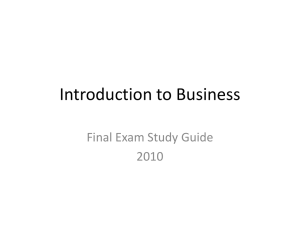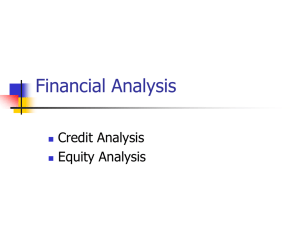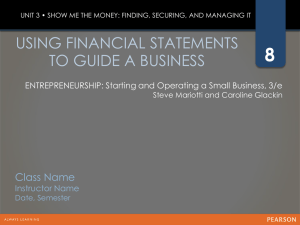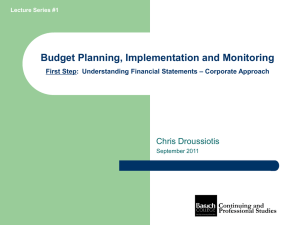Financial Statement Presentation
advertisement
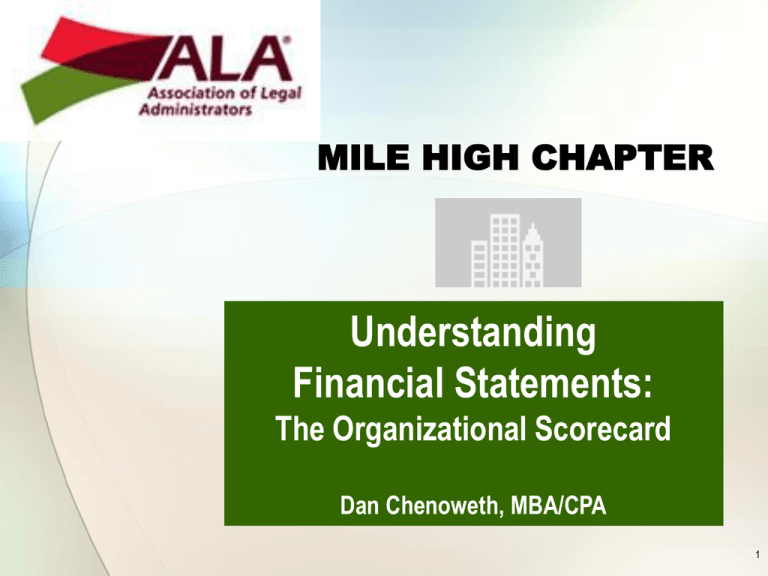
MILE HIGH CHAPTER Understanding Financial Statements: The Organizational Scorecard Dan Chenoweth, MBA/CPA 1 Premise • Every organization needs a “Scorecard” to measure success • Financial Statements are the Scorecard • Two types of Accounting Records • Textbook (“Accrual Basis”) Financial Statements • Cigar Box (“Cash Basis”) Financial Statements 2 Presentation Objectives • THE BASICS Overview of Accrual Basis Financials • • • • Definition Overview of the “Big 3” Financial Statements Importance of Key Ratio Analysis Overview of Cash Basis Financials • • Definition Internal Controls LATEST FINANCIAL REPORTING TRENDS • Turning Data into Information: The Balanced Scorecard 3 Accrual Basis Financials DEFINITION: Financial Statements prepared in accordance with Generally Accepted Accounting Principles (GAAP): • Revenues recorded at time goods and services are delivered, regardless of when customer pays • Expenses recorded at time goods and services are purchased, regardless of when you pay the bill 4 Accrual Basis Financials The “Big 3” Balance Sheet “A Snapshot in Time” Income Statement “The Moving Picture” Statement of Cash Flow “Cash is King” 5 Balance Sheet Overview Purpose: A “snap shot” in time regarding organization’s financial position Components: Assets = Liabilities + Owners’ Equity Assets – Liabilities = Owners’ Equity Current Assets: • Cash • Accounts Receivable • Client Trust Funds • Deposits & Prepaids Fixed Assets (Net of Accum. Depr.) TOTAL ASSETS Current Liabilities: • Accounts Payable • Accrued Expenses • Short-Term Loans/Debt Long-Term Loans/Debt Capital & Draw (Owners’ Equity) • Partners’ Capital Contribution • (Partners’ Draw / Distributions) • Retained Earnings TOTAL LIABILITIES / CAPITAL & DRAW 6 Balance Sheet Example Current Assets: • Cash $100 • Accounts Rec. 300 • Client Trust Funds 500 • Deposits & Prepaids 50 Total Current Assets 950 Fixed Assets (Net of A/D) 1050 TOTAL ASSETS $2000 Current Liabilities: •Accounts Payable •Accrued Expenses •S-T Loans/Debt Total Current Liabilities L-T Loans/Debt Total Liabilities Capital & Draw (Owners’ Equity) •Beginning Capital •Partners’ Capital Contribution •(Partners’ Draw / Distributions) •Profit (Loss) Total Capital & Draw TOTAL LIABILITIES / CAP & DRAW $200 50 250 500 600 1100 780 20 (10) ??? ??? $ ??? 7 Balance Sheet Answers Current Assets: • Cash $100 • Accounts Rec. 300 • Client Trust Funds 500 • Deposits & Prepaids 50 Total Current Assets 950 Fixed Assets (Net of A/D) 1050 TOTAL ASSETS $2000 Current Liabilities: •Accounts Payable •Accrued Expenses •S-T Loans/Debt Total Current Liabilities L-T Loans/Debt Total Liabilities Capital & Draw (Owners’ Equity) •Beginning Capital •Partners’ Capital Contribution •(Partners’ Draw / Distributions) •Profit (Loss) Total Capital & Draw TOTAL LIABILITIES / CAP & DRAW $200 50 250 500 600 1100 780 20 (10) 110 900 $ 2000 8 Balance Sheet Key Questions Liquidity: Is Working Capital positive? That is, are there enough Current Assets to pay all Current Liabilities? Solvency: Is Capital & Draw (Owners’ Equity) positive? Debt vs. Equity: Who has more “skin in the game”? The partners or the bank? How well is the firm doing in utilizing and managing its assets and leveraging its debt? 9 Income Statement Overview Purpose: A statement of income and expenditures over a specified time period to determine if profits or losses have been earned. Components: Revenue – Expenses = Profit or Loss Revenue: • Fees from Insurance Companies • Fees from Private Clients • Other Income (Rental, Interest, etc.) TOTAL REVENUE Expenses: $2000 50% 1800 45% 200 5% 4000 100% Guaranteed payments, Payroll, Payroll Taxes, Fringe Benefits, Education, Rents, Supplies, Depreciation, Entertainment, Dues, Insurance, Telephone Operating Profit or Loss Interest Expense Net Income 3850 150 -40 $ 110 96% 4% 1% 3% 10 Income Statement Key Questions PROFITABILITY: • Did we earn a profit? What is our rate of return? INTERNAL BENCHMARKING / TRENDS: • Are revenues higher or lower than the last period? • Are expenses higher or lower than the last period? • How did we do this month vs. last month? This quarter vs. last quarter? This year vs. last year? • How do our actual results compare to budget? EXTERNAL BENCHMARKING: • How do our firm’s financials compare to others in our industry? Did we earn a reasonable profit commensurate with the risk assumed? 11 Statement of Cash Flow Overview Purpose: Explains movement of money in and out of the organization’s cash accounts during a particular time period. Provides explanation for changing amounts in the organization’s accounts. Components: The “bridge” between the Balance Sheet and Income Statement as it contains elements of both. Must know both beginning AND end of period Balance Sheet amounts. 12 Statement of Cash Flow Example Begin Cash Balance (Per Prior Year’s B/S) $110 Cash Flow from Operating Activities • Net Income (Per Income Statement) 110 • Add back Depreciation Expense (Per I/S) 20 • Changes in Current Assets & Liabilities (Per B/S) -40 Net Cash Provided by Operating Activities 90 Cash Flow from Investing Activities: • Purchase Fixed Assets (Per B/S) -50 Cash Flow from Financing Activities: • Repay Bank Loans (Per B/S) -60 • Partners’ Capital Contributions $20 less Draw $10 10 Ending Cash Balance (Ending Balance per this year’s B/S) $100 13 Statement of Cash Flow Key Questions SOLVENCY: Did we have positive cash flow from operating activities? (If answer is “no,” indicator of big problems!) CASH MANAGEMENT: How did we invest any excess cash? Did we reinvest in the business? Purchase CD’s? FINANCING: • Did we have to borrow more money in order to finance operations or invest in the business? Did the partners have to contribute more? • Did we generate enough cash that we could repay some or all of our bank debt? Is there sufficient cash for partner draws / distributions? FORECASTING: Do we have sufficient cash on hand to cover normal operating expenses for next few months? “Where does our money come from and where does it go?” 14 Key Ratio Analysis “Not everything that counts can be counted; not everything that can be counted really counts.” Albert Einstein “So now that we have all these numbers, what are we going to do with them?” Dan Chenoweth I earned $1 million in the stock market last year. Is that a good return? 15 Results to Resources Ratio RRR RRR DEFINED: What Resources were spent to achieve what Result? • Resources: Time, space, equipment, people, budget, training, etc. • Result: Did activity improve our profits? RATIO = Numerator / Denominator RRR = Results / Resources 16 Key Ratio Analysis (Examples - See Handout) 1. 2. 3. 4. 5. Liquidity Ratios: Indicator of short-term solvency Profitability Ratios: Indicator of return on investment (i.e. return for resources expended) Activity Ratios: Indicator of how well organization’s resources have been utilized Leverage Ratios: Indicator of extent to which operations are financed with borrowed money vs. owners’ money Other Ratios: Primarily associated with publicly held companies 17 Key Ratio Analysis Benchmarking Internal Benchmarking / Trend Analysis: Compare yourself with yourself • • Current month vs. previous month Current year vs. previous year External Benchmarking: Compare your organization with others in the same industry. Your Org. Industry Avg. Current Ratio: CA/CL $950/$500 1.90 2.00 ROI: NI / Total Assets $110/$2000 5.50% 5.68% 45 days 30 Days 1.22 1.45 Avg. Collection Period: (Avg. A/R ) / (Revenues/365) Debt/Equity: $1100/$900 18 Cash Basis Financials “Cigar Box” Accounting DEFINITION • Revenues recorded at time cash is received from customers • Expenses recorded at time cash is paid to vendors 19 Internal Controls QUIZ: How Weak Are Your Internal Controls? 20 How to Improve Internal Controls #1: Outside Audit #2: “Checks and Balances” • Cash Receipts • Cash Disbursements #3: Accounting Personnel • Integrity and Rotation #4: Partners / Owners Financial Review • Involvement - Budget / Forecast • Understanding • Questioning 21 Organization Stakeholders Successful organizations make decisions that consider the best interests of four primary stakeholders CLIENTS EMPLOYEES OWNERS SOCIETY 22 Balance of Measures • • • • • Quality Cost Delivery / Cycle Time Safety / Morale Reputation 23 The Balanced Scorecard • Associated with Kaplan and Norton at Harvard University. • Choose key performance indicators (KPIs) based on critical success factors (CSFs): • Based on unique business strategy. • Measurables for companies in the same industry should be different. 24 The Balanced Scorecard Financial Learning & Growth Strategy & Vision Customer Operations 25 Learning & Innovation Measurable examples: • • • • • Number of new services introduced Service introduction lead-time Training hours per person Employee turnover Employee satisfaction 26 Operational Measurement Examples: • • • • Operational efficiency, e.g. lack of errors Billable hours Revenue per employee Revenue per type of service offered • Revenue per client 27 Customer Perspective Measurement examples: • • • • • Customer Quality Ratings Speed of Service Repeat Customers New Customer Acquisition Market Share 28 Financial Perspective Measurement examples: • • • • • Profit Shareholder value-added (SVA) Debt/Equity Return on investment Return on assets 29 Southwest Airlines 30 Executive Education, Inc. Objectives Financial Customer Profitable Business Measures Initiatives 4.7 Knowledge 4.6 Presentation 4.5 Materials DL Knowledge Sharing $ Profit / # Seminar Days Average Knowledge, Presentation & Materials Scores High Participant Scores Targets (5-pt. scale) “Go” Rate Operations Registrations Repeat Attendees Learning Executive Education, Inc., © 2011 New Material High Quality Materials # Go Seminars / # Scheduled Seminars Jan-Aug 90% Sept-Dec 95% # People / #Seminars 25+ (average) Pamphlets E-mail blasts % New Titles or Sections 25% New Material Seminar Surveys MS Word Style Analysis 0% Passives 40 Readability 12 Grade level “Story” Cases New Editing Standards 31 Balanced Scorecard Example From Professional Services Firm ALLEN, LEACH & TUREK, PC 32 33 34 Final Quiz 1. 2. 3. 4. 5. 6. 7. What are the “Big 3” Financial Statements? Which of these Financial Statements is the “bridge” between the other two? What does “RRR” mean? Why is Key Ratio Analysis important? Which is better: Accrual basis accounting or Cash basis accounting? Who are an organization’s four key stakeholders? What are the components of the “Balance of Measures”? HINT: Q,C,D,S,M,R 35 Conclusion “If you torture numbers long enough, you can make them confess to anything.” Former NM Senator Pete Domenici in discussing the Federal Government budgeting process Don’t be a number torturer and don’t let numbers torture you! Instead, understand the critical elements in Financial Statements and know how to turn data into information! 36





